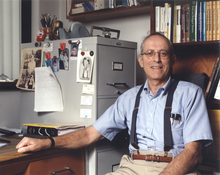Irwin Fridovich
Irwin Fridovich | |
|---|---|
 Irwin Fridovich in 1994 | |
| Born | August 2, 1929 New York City |
| Citizenship | United States |
| Alma mater | City College of New York (BS 1951), Duke University (PhD 1955) |
| Known for | superoxide dismutase, oxygen free radicals |
| Awards | Elliott Cresson Medal (1997) |
| Scientific career | |
| Fields | Biochemistry |
| Institutions | Duke University |
| Doctoral advisor | Philip Handler |
| Doctoral students | Joe M. McCord, Hara P. Misra |

Irwin Fridovich is an American biochemist who, together with his graduate student Joe M. McCord, discovered the enzymatic activity of copper,zinc superoxide dismutase (SOD),[1][2]—to protect organisms from the toxic effects of superoxide free radicals formed as a byproduct of normal oxygen metabolism.[3] Subsequently, Fridovich's research group also discovered the manganese-containing[4] and the iron-containing[5] SODs from E coli and the mitochondrial MnSOD (SOD2),[6] now known to be an essential mammalian protein.[7] He spent the rest of his career studying the biochemical mechanisms of SOD and of biological superoxide toxicity, using bacteria as model systems.[8][9][10] Fridovich is currently Professor Emeritus of Biochemistry at Duke University.
Academic career
From 1951 to 1952, Fridovich served as a medical research associate at Cornell Medical College. He held junior teaching positions in biochemistry at Duke University 1956 to 1961 and was a visiting research associate at Harvard University from 1961 to 1962. He became an assistant professor in biochemistry at Duke University in 1961 and a full professor in 1971. He was appointed as James B. Duke Professor of Biochemistry in 1976 and has held the position as professor emeritus since 1996.
Awards and honors
Fridovich has received numerous awards and recognitions for his work, including membership in the National Academy of Sciences and the American Academy of Arts and Sciences, and the Elliott Cresson Medal of the Franklin Institute, Philadelphia. According to Google Scholar, he has over 51,000 citations in the scientific literature, including 7 papers with >1000 citations, and an H-index of 97.[11] His discovery of the superoxide dismutase reaction essentially started the field of oxygen free radicals in biology and medicine,[10][12] and that influence is shown by his election as president of the American Society of Biological Chemists (for 1982–83)[1], the Oxygen Society (1987–1990), and the Society for Free Radical Research (1992–94), as well as award of the Science & Humanity Prize at the 2000 Oxygen Club World Congress.
References
- ^ McCord JM, Fridovich I (1969). "Superoxide Dismutase, An Enzymic Function for Erythrocuprein (Hemocuprein)". Journal of Biological Chemistry. 244 (22): 6049–6055. PMID 5389100.
- ^ Fridovich I (1998). "The trail to superoxide dismutase". Protein Science. 7: 2688–2690. doi:10.1002/pro.5560071225. PMC 2143889.
- ^ Bannister WH, Bannister JV. "Isolation and characterization of superoxide dismutase: a personal history and tribute to Joe McCord and Irwin Fridovich". Free Radical Biology and Medicine. 5: 371–6. doi:10.1016/0891-5849(88)90110-4.
- ^ BB Keele Jr; JM McCord; I Fridovich (1970). "Superoxide Dismutase from Escherichia coli B: A new manganese-containing enzyme". Journal of Biological Chemistry. 245 (22): 6176–6181. PMID 4921969.
- ^ FJ Yost Jr; I Fridovich (1973). "An iron-containing superoxide dismutase from Escherichia coli". Journal of Biological Chemistry. 248 (14): 4905–4908. PMID 4352182.
- ^ Weisiger RA, Fridovich I (1973). "Superoxide Dismutase: Organelle specificity". Journal of Biological Chemistry. 248: 3582–3592.
- ^ McCord JM, Fridovich I (1988). "Superoxide dismutase: the first twenty years (1968-1988)". Free Radical Biology and Medicine. 5 (5–6): 363–9. doi:10.1016/0891-5849(88)90109-8. PMID 2855736.
- ^ Fridovich I (1978). "The biology of oxygen radicals". Science. 201: 875–880. Bibcode:1978Sci...201..875F. doi:10.1126/science.210504.
- ^ Fridovich I (1995). "Superoxide radical and superoxide dismutases". Annual Review of Biochemistry. 64: 97–112. doi:10.1146/annurev.bi.64.070195.000525.
- ^ a b Kresge N, Simoni RD, Hill RL (2006). "Forty Years of Superoxide Dismutase Research: the Work of Irwin Fridovich (JBC Classics: Enzymology)". The Journal of Biological Chemistry. 281 (22): e17. Retrieved July 3, 2011.
{{cite journal}}: CS1 maint: multiple names: authors list (link) - ^ "Irwin Fridovich". Google Scholar. Retrieved 3 July 2012.
- ^ Imlay JA (2011). "Redox pioneer: professor Irwin Fridovich". Antioxidants & Redox Signaling. 14 (3): 335–40. doi:10.1089/ars.2010.3264. PMC 3026652. PMID 20518701.
